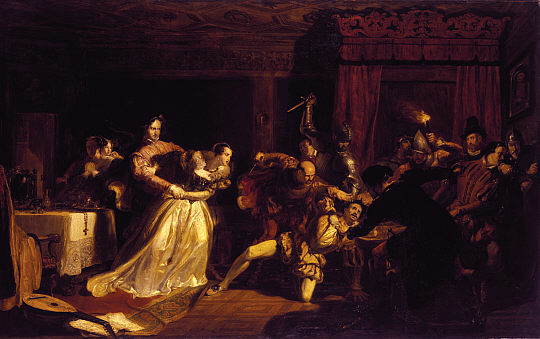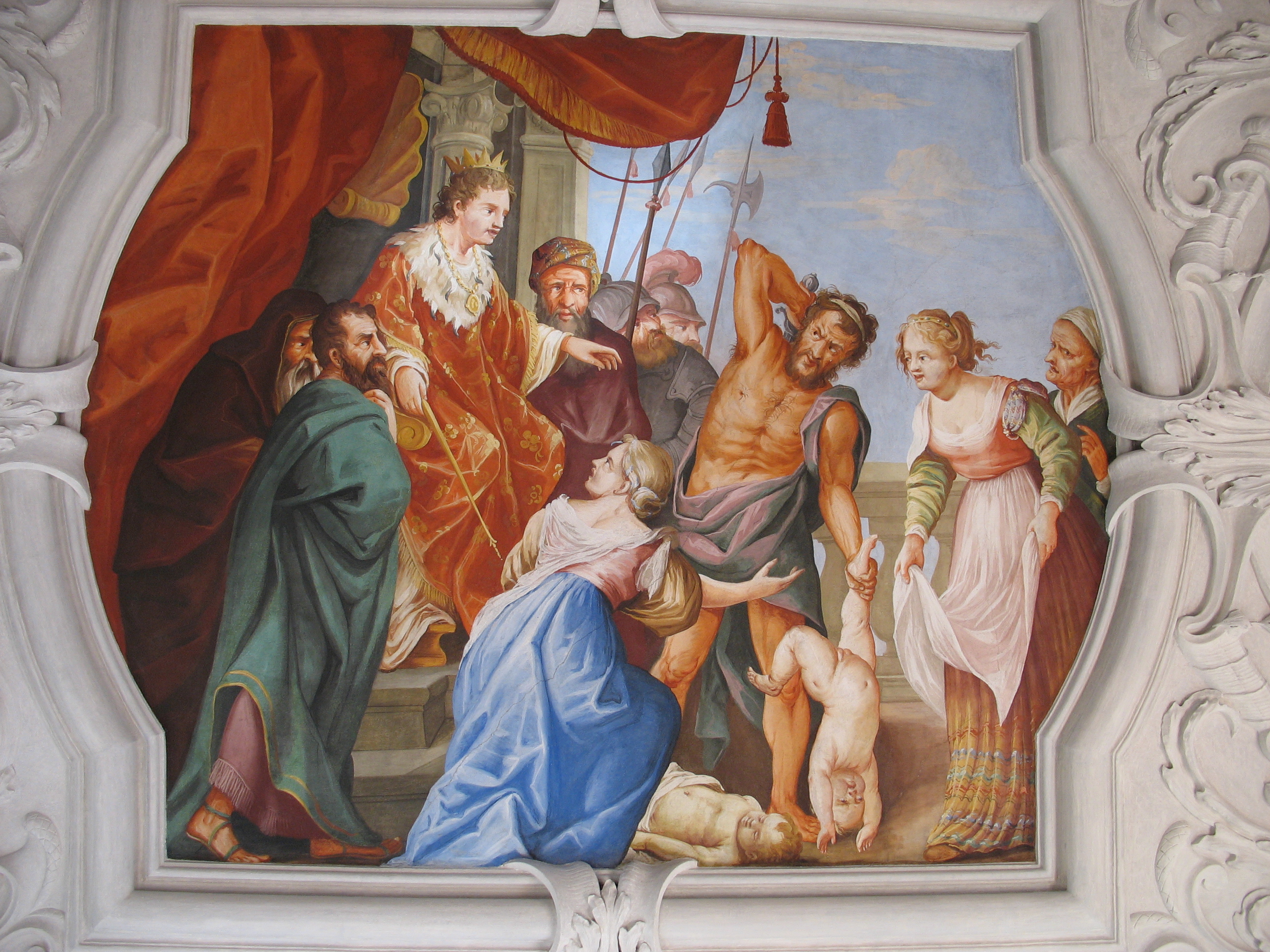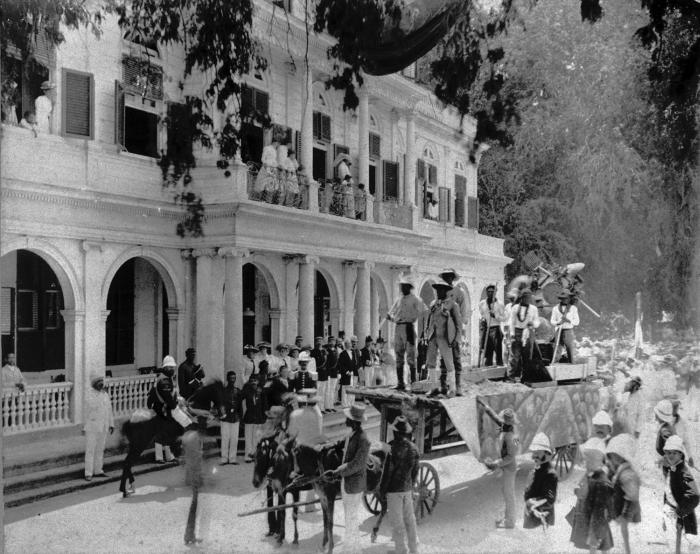|
Entry Of James VI Into Edinburgh
A royal entry into Edinburgh marked the coming of age of King James VI of Scotland as an adult ruler on 19 October 1579. The 13-year-old king came to Edinburgh to begin his adult rule, having spent his childhood at Stirling Castle. A royal entry was the usual way across Europe of marking a new monarch, or one making his first visit to a city. A representation of the astrologer Ptolemy signalled the transition of James to adulthood, and he was given a sword and sceptre, symbols of kingship, known as the Honours of Scotland. Events According to David Moysie, James VI left Stirling on 29 September 1579 despite a storm. He had lunch at Dunipace and dinner at Linlithgow Palace where he stayed the night, and came to Holyroodhouse the next evening. The town lined the road with men in armour and a salute was fired from Edinburgh Castle. James arrived from Dalkeith Palace. The processional route went from the West Port, to the Overbow, to the Tolbooth, to St Giles Cathedral, St Giles Kir ... [...More Info...] [...Related Items...] OR: [Wikipedia] [Google] [Baidu] |
Tolbooth
A tolbooth or town house was the main municipal building of a Scotland, Scottish burgh, from medieval times until the 19th century. The tolbooth usually provided a council meeting chamber, a court house and a jail. The tolbooth was one of three essential features in a Scottish burgh, along with the mercat cross and the kirk (church). Etymology The word tolbooth is derived from the Middle English word ''tolbothe'' that described a town hall containing customs offices and prison cells. History Burghs were created in Scotland from the 12th century. They had the right to hold markets and levy customs and tolls, and tolbooths were originally established for collection of these. Royal burghs were governed by an elected council, led by a Provost (civil), provost and baillies, who also acted as magistrates with jurisdiction over local crime. The tolbooth developed into a central building providing for all these functions. Most tolbooths had a bell, often mounted on a steeple, and l ... [...More Info...] [...Related Items...] OR: [Wikipedia] [Google] [Baidu] |
Regent Morton
James Douglas, 4th Earl of Morton (c. 1516 – 2 June 1581) was a Scottish nobleman. He played a leading role in the murders of Queen Mary's confidant, David Rizzio, and king consort Henry Darnley. He was the last of the four regents of Scotland during the minority of James VI. He was in some ways the most successful of the four since he won the civil war that had been dragging on with the supporters of the exiled Mary, Queen of Scots. However, he came to an unfortunate end, executed by means of the Maiden, a predecessor of the guillotine. Biography Early life James Douglas was the second son of Sir George Douglas of Pittendreich, Master of Angus, and Elizabeth Douglas, daughter of David Douglas of Pittendreich. He wrote that he was over 61 years old in March 1578, so was probably born around 1516. Before 1543, he married Elizabeth, daughter of James Douglas, 3rd Earl of Morton, and became known as the "Master of Morton". In 1553, James Douglas succeeded to the title ... [...More Info...] [...Related Items...] OR: [Wikipedia] [Google] [Baidu] |
Running At The Ring
Running at the ring, riding at the ring or tilting at the ring is an equestrian tournament activity originally practiced at European royal courts and likely derived from other lance games like Quintain (jousting), quintain. It gained new popularity at Natural Chimneys near Mount Solon, Virginia, possibly as early as the 1820s, and since 1962, has been the state sport of Maryland. A similar contest, the ''corrida de sortija'', is held in Argentina where it is considered a gaucho sport derived from the Spanish tradition of medieval tournaments. Description Participants rode at full speed to thrust the point of the lance through a ring or to hook a ring and carry it off. A performer was allowed three attempts. The French author and riding master Antoine de Pluvinel published descriptions and the rules. The lance was shorter than those used for jousting, and had no protective vamplate. Costumed court festival This version of a Hastilude, lance game or Quintain (jousting), quintain cou ... [...More Info...] [...Related Items...] OR: [Wikipedia] [Google] [Baidu] |
Esmé Stewart, 1st Duke Of Lennox
Esmé Stewart, 1st Duke of Lennox, 1st Earl of Lennox, 6th Seigneur d'Aubigny (26 May 1583) of the Château d'Aubigny at Aubigny-sur-Nère in the ancient Provinces of France, province of Berry, France, Berry, France, was a Catholic French nobleman of Scottish ancestry who on his move to Scotland at the age of 37 became a favourite of the 13-year-old King James VI and I, James VI of Scotland (and later I of England). Esmé Stewart was the first cousin of James' father, Henry Stewart, Lord Darnley (son and heir apparent of Matthew Stewart, 4th Earl of Lennox). Despite his conversion to Calvinism he was never trusted by the Scots and returned to France where he ended his days. Sir James Melville described him as "of nature upright, just and gentle". He was the first to popularise the firstname Esmé (spelt also Edme, etc.) in the British Isles. Early life He was the son and heir of John Stewart, 5th Seigneur d'Aubigny (d. 1567), by his wife Anne de la Queuille, a French noblewoma ... [...More Info...] [...Related Items...] OR: [Wikipedia] [Google] [Baidu] |
Holyrood Palace
The Palace of Holyroodhouse ( or ), commonly known as Holyrood Palace, is the official residence of the British monarch in Scotland. Located at the bottom of the Royal Mile in Edinburgh, at the opposite end to Edinburgh Castle, Holyrood has served as the principal royal residence in Scotland since the 16th century, and is a setting for state occasions and official entertaining. The palace adjoins Holyrood Abbey, and the gardens are set within Holyrood Park. The King's Gallery, Edinburgh, King's Gallery was converted from existing buildings at the western entrance to the palace and was opened in 2002 to exhibit works of art from the Royal Collection. Charles III, King Charles III spends one week in residence at Holyrood at the beginning of summer, where he carries out a range of official engagements and ceremonies. The 16th-century historic apartments of Mary, Queen of Scots, and the State Apartments, used for official and state entertaining, are open to the public throughout ... [...More Info...] [...Related Items...] OR: [Wikipedia] [Google] [Baidu] |
Horoscope
A horoscope (or other commonly used names for the horoscope in English include natal chart, astrological chart, astro-chart, celestial map, sky-map, star-chart, cosmogram, vitasphere, radical chart, radix, chart wheel or simply chart) is an astrological chart or diagram representing the positions of the Sun, Moon, planets, astrological aspects and angles at the time of an event, such as the moment of a person's birth. The word horoscope is derived from the Greek words ''ōra'' and ''scopos'' meaning "time" and "observer" (''horoskopos'', pl. ''horoskopoi'', or "marker(s) of the hour"). It is claimed by proponents of astrology that a horoscope can be used as a method of divination regarding events relating to the point in time it represents, and it forms the basis of the horoscopic traditions of astrology, although practices surrounding astrology have been recognized as pseudoscientific since the 18th century. Horoscope columns are often featured in print and online newspapers. ... [...More Info...] [...Related Items...] OR: [Wikipedia] [Google] [Baidu] |
Bacchus
In ancient Greek religion and myth, Dionysus (; ) is the god of wine-making, orchards and fruit, vegetation, fertility, festivity, insanity, ritual madness, religious ecstasy, and theatre. He was also known as Bacchus ( or ; ) by the Greeks (a name later adopted by the Romans) for a frenzy he is said to induce called ''baccheia''. His wine, music, and ecstatic dance were considered to free his followers from self-conscious fear and care, and subvert the oppressive restraints of the powerful. His ''thyrsus'', a fennel-stem sceptre, sometimes wound with ivy and dripping with honey, is both a beneficent wand and a weapon used to destroy those who oppose his cult and the freedoms he represents. Those who partake of his mysteries are believed to become possessed and empowered by the god himself. His origins are uncertain, and his cults took many forms; some are described by ancient sources as Thracian, others as Greek. In Orphism, he was variously a son of Zeus and Perseph ... [...More Info...] [...Related Items...] OR: [Wikipedia] [Google] [Baidu] |
Psalm 21
Psalm 21 is the 21st psalm of the Book of Psalms, beginning in English in the King James Version: "The king shall joy in thy strength". The Book of Psalms is part of the third section of the Hebrew Bible, and a book of the Christian Old Testament. In the slightly different numbering system used in the Greek Septuagint and Latin Vulgate translations of the Bible, this psalm is Psalm 20. In Latin, it is known by the incipit, "". The psalm is attributed to David. Psalm 21 is used in both Jewish and Christian liturgies. It has often been set to music, especially for royal functions, such as Handel's Coronation anthems. Themes This royal psalm and the previous one are closely related: they are both liturgical psalms; in both, the king is the prominent figure. Psalm 21 is characterised as a psalm of thanksgiving. It focuses on the imagery of a king; the king is often credited with being an example of the moral state of a kingdom in the Old Testament. Commentary by the theologia ... [...More Info...] [...Related Items...] OR: [Wikipedia] [Google] [Baidu] |
Judgement Of Solomon
The Judgement of Solomon is a story from the Old Testament in which Solomon ruled between two women who both claimed to be the mother of a child. Solomon ordered the baby be cut in half, with each woman to receive one half. The first woman accepted the compromise as fair, but the second begged Solomon to give the baby to her rival, preferring the baby to live, even without her. Solomon ordered the baby given to the second woman, as her love was selfless, as opposed to the first woman's selfish disregard for the baby's actual well-being. Some consider this approach to justice an archetype, archetypal example of an impartial judge displaying wisdom in making a ruling. Biblical narrative recounts that two mothers living in the same house, each the mother of an infant son, came to Solomon. One of the babies Overlaying, had been smothered, and each claimed the remaining boy as her own. Calling for a sword, Solomon declared his judgment: the baby would be cut in two, each woman to re ... [...More Info...] [...Related Items...] OR: [Wikipedia] [Google] [Baidu] |
Tableau Vivant
A (; often shortened to ; ; ) is a static scene containing one or more actors or models. They are stationary and silent, usually in costume, carefully posed, with props and/or scenery, and may be theatrically illuminated. It thus combines aspects of theatre and the visual arts. They were a popular medieval form that revived considerably from the 19th century, probably as they were very suitable for recording by photography. The participants were now mostly amateurs, participating in a quick and easy form of amateur dramatics that could be brought together in an evening, and required little skill in acting or speaking. They were also popular for various sorts of community events and parades. In the late 19th and early 20th centuries, there was also a type of ''tableau'' used in the professional theatre, taking advantage of the extra latitude the law allowed for the display of nudity so long as the actors did not move. Tableaux featured ('flexible poses') by virtually nude ... [...More Info...] [...Related Items...] OR: [Wikipedia] [Google] [Baidu] |
John Shairp (lawyer)
John Schairp of Houston (died 1607) was a Scottish lawyer and businessman. Schairp studied at the University of St Andrews for the church, but changed careers and became a lawyer. His practice included work for Edinburgh town council and many private clients. He also lent money to aristocrats like John Lyon, 8th Lord Glamis. Houston House is at Uphall in West Lothian. The lands were called Stathbrock when he bought them in 1569. The lands were erected into a barony for Shairp, but he had to defend his ownership of the property from various claimants. Schairp completed a new Houston House which still stands. He gave a speech in Latin at the Entry of James VI into Edinburgh. On 12 July 1593 he acted as proxy for John Maitland of Thirlestane and his wife Jean Fleming when they resigned the barony of Musselburgh to Anne of Denmark. In 1604 he became involved in a commission to re-draft border law preparatory to the projected union between Scotland and England. He died in 1607. ... [...More Info...] [...Related Items...] OR: [Wikipedia] [Google] [Baidu] |





